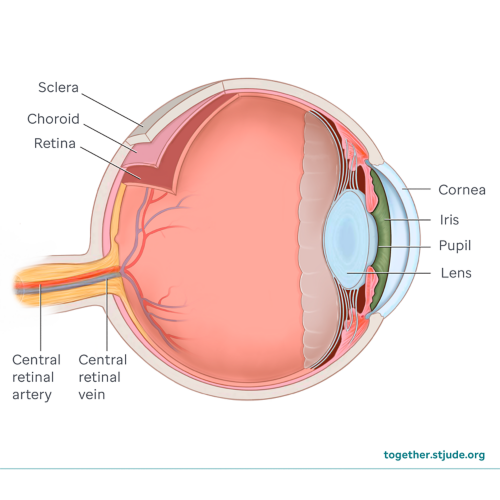What is sickle cell retinopathy?
Sickle cell retinopathy is an eye condition that affects some people with sickle cell disease. Retinopathy is damage to the retina, the part of the eye that senses light. Retinopathy can happen in 1 or both eyes. Early damage does not usually affect vision, but eye problems can worsen over time.
Proliferative sickle cell retinopathy (PSR)
PSR is the most serious type of sickle cell retinopathy. It can cause:
- Bleeding in the eye
- Retinal detachment where the retina separates from its normal position
- Vision loss
- Blindness (in rare cases)
Symptoms of sickle cell retinopathy
Signs and symptoms of retinopathy include:
- Seeing spots or floaters
- Blurred vision
- Having trouble seeing colors
- Vision loss
People with sickle cell retinopathy may have no symptoms in the early stages of the condition.
Causes of sickle cell retinopathy
In sickle cell disease, red blood cells become hard, sticky, and shaped like a banana (sickle-shaped). Sickle cells clump together and clog blood vessels. The cells block tiny blood vessels and slow the delivery of blood and oxygen. The lack of oxygen can damage the retina, causing vision problems.
Anyone with sickle cell disease can develop sickle cell retinopathy. But it is more common in certain types of sickle cell disease. These include sickle hemoglobin C (HbSC) disease and sickle beta plus (Sβ+) thalassemia. Up to 1 in 3 people with these forms of sickle cell disease may develop retinopathy.
Diagnosis of sickle cell retinopathy
Regular eye exams by a trained provider can detect retinopathy and other eye problems. Children with sickle cell disease should begin having regular eye exams to check for sickle cell retinopathy at age 9 or 10.
- Children with sickle hemoglobin C (HbSC) disease need an eye exam every year.
- Children with other types of sickle cell disease need an eye exam every other year.
Retinopathy can go undetected for years without an eye exam by a trained eye doctor. Be sure your child has regular eye exams by a retina specialist who is familiar with sickle cell disease. Advanced imaging tests are used to examine blood vessels in the retina and check for thinning of the retina.
If your child has signs of retinopathy, they may need more frequent exams. It is important to have these eye exams on schedule. Blindness is rare in patients who regularly see an eye doctor. If left untreated, 10% (1 in 10) of people with sickle cell retinopathy may develop vision problems.
Treatments for sickle cell retinopathy
Managing sickle cell disease helps limit retinopathy and other complications. Keep all medical appointments and follow your child’s recommended treatment plan.
Treatments for more severe sickle cell retinopathy include:
- Laser treatments
- Medicines to prevent new blood vessels from forming
- Surgery for a detached retina
Speak with your child’s care team if you have questions or concerns. They are available to help you.
Questions to ask your care team
—
Reviewed: September 2024

